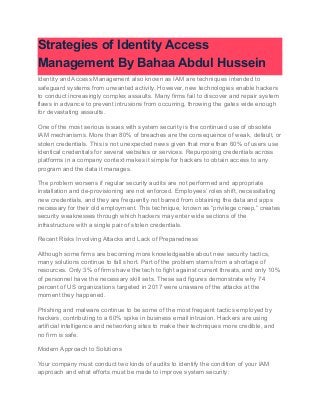Strategies of Identity Access Management By Bahaa Abdul Hussein.pdf
- 1. Strategies of Identity Access Management By Bahaa Abdul Hussein Identity and Access Management also known as IAM are techniques intended to safeguard systems from unwanted activity. However, new technologies enable hackers to conduct increasingly complex assaults. Many firms fail to discover and repair system flaws in advance to prevent intrusions from occurring, throwing the gates wide enough for devastating assaults. One of the most serious issues with system security is the continued use of obsolete IAM mechanisms. More than 80% of breaches are the consequence of weak, default, or stolen credentials. This is not unexpected news given that more than 60% of users use identical credentials for several websites or services. Repurposing credentials across platforms in a company context makes it simple for hackers to obtain access to any program and the data it manages. The problem worsens if regular security audits are not performed and appropriate installation and de-provisioning are not enforced. EmployeesŌĆÖ roles shift, necessitating new credentials, and they are frequently not barred from obtaining the data and apps necessary for their old employment. This technique, known as ŌĆ£privilege creep,ŌĆØ creates security weaknesses through which hackers may enter wide sections of the infrastructure with a single pair of stolen credentials. Recent Risks Involving Attacks and Lack of Preparedness Although some firms are becoming more knowledgeable about new security tactics, many solutions continue to fall short. Part of the problem stems from a shortage of resources. Only 3% of firms have the tech to fight against current threats, and only 10% of personnel have the necessary skill sets. These sad figures demonstrate why 74 percent of US organizations targeted in 2017 were unaware of the attacks at the moment they happened. Phishing and malware continue to be some of the most frequent tactics employed by hackers, contributing to a 60% spike in business email intrusion. Hackers are using artificial intelligence and networking sites to make their techniques more credible, and no firm is safe. Modern Approach to Solutions Your company must conduct two kinds of audits to identify the condition of your IAM approach and what efforts must be made to improve system security:
- 2. ŌĆó Security audit ŌĆō Identifies flaws in security procedures ŌĆó IAM audit ŌĆō Identifies instances of permission creep and obsolete or defunct accounts Performing periodic audits frequently eliminates access control issues and assists your IT department in staying on top of critical security changes. Implement a mechanism to track and analyze user behavior to preserve security between audits. Modern tracking apps use machine learning (ML) algorithms to discern between regular behavior patterns and harmful deviations, resulting in better access control solutions.


